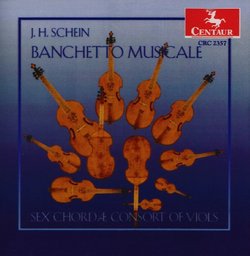| All Artists: Johann Hermann Schein, Sex Chordae Consort of Viols Title: J. H. Schein: Banchetto Musicale Members Wishing: 1 Total Copies: 0 Label: Centaur Release Date: 8/12/2000 Genre: Classical Styles: Opera & Classical Vocal, Chamber Music, Historical Periods, Baroque (c.1600-1750), Early Music Number of Discs: 1 SwapaCD Credits: 1 UPCs: 789368630721, 044747235721 |
Search - Johann Hermann Schein, Sex Chordae Consort of Viols :: J. H. Schein: Banchetto Musicale
 | Johann Hermann Schein, Sex Chordae Consort of Viols J. H. Schein: Banchetto Musicale Genre: Classical
|
Larger Image |
CD Details |
CD ReviewsMusical Banquet Giordano Bruno | Wherever I am, I am. | 11/29/2007 (3 out of 5 stars) "The title gives an important clue; this is delightful but unchallenging occasional music - background music for dining parties. Every composer of the early and middle baroque wrote somesuch; another example would be Biber's "Mensa Sonora", which means the same thing in a different dialect. In the music-for-hire racket, we call this stuff "wallpaper music." Sex Chordae means six strings, the usual number on a viola da gamba. There is a splendid repertoire of music by English and German composers of "closed" consorts of gambas, and there are quite a few CDs of that repertoire more interesting than this. The ensemble Sex Chordae is, to my ears, competent but not exciting. Better performances are available from FRETWORK and PHANTASM ensembles, and for the French and Spanish gamba repertoire there is no better interpreter than Jordi Savall with his various ensembles." German Viol Consorts from California Leslie Richford | Selsingen, Lower Saxony | 10/11/2008 (4 out of 5 stars) "Johann Hermann Schein: Banchetto Musicale (published in Leipzig in 1617). Performed by the Sex Chordae Consort of Viols, dir. John Dornenburg [John Dornenburg, Julie Jeffrey, Amy Brodo, Michael Sand, Farley Pearce]. Recorded in March 1996 at the Chapel of the Cross at Pacific Lutheran Theological Seminary, Berkeley, California. Published in 1997 as Centaur CRC 2357. Total playing time: 58'11".
This disc is unusual in a number of ways: Five musicians from California, of whom one - Michael Sand - is better known as a virtuoso player of the baroque violin - here play German dance music from the time of the 30 Years War on a number of differently-sized violas da gamba - and they do it for a label from Baton Rouge, Louisiana! But after listening I can only say, "Why not?" The five Americans manage to play the eight "suites" consisting of one each of "Padouane", "Gagliarda", "Courente" and "Allemande-Tripla" in such a differentiated, lively way, and so near to the dancing original, that there is never a question of boredom, even after almost an hour. In particular, the "Sex Chordae" avoid that typical lamenting tone which seems to be a characteristic of English viol consort playing. In his notes, John Dornenburg points to a number of passages where Schein has quoted from popular English viol consorts (mainly by Dowland), but also makes it plain that Schein was not merely copying but was making these really his own. - As long as one doesn't expect the miraculous, one can well understand why this recording was chosen as "Disc of the Month" by the German early music magazine "Alte Musik aktuell" (July/August 1998) and loaded with praise such as "warmth and musicality" or "tight and energetic". Schein's viol consorts cannot really reach the heights of works by William Byrd or John Dowland, nor do they generate the excitement of, say, Michael Praetorius's collections of dance music, but they are, nonetheless, well worth the hearing and here give a good impression of German musicianship on the threshhold of the baroque era." |

 Track Listings (31) - Disc #1
Track Listings (31) - Disc #1